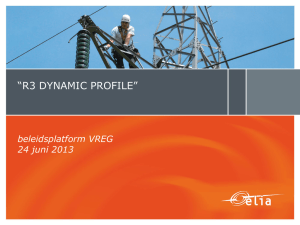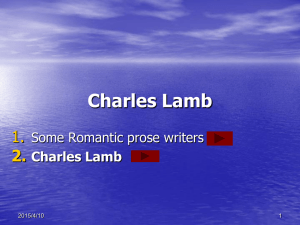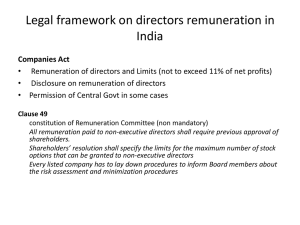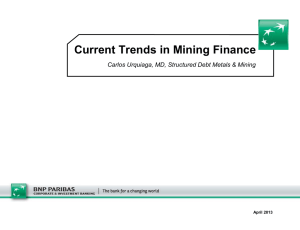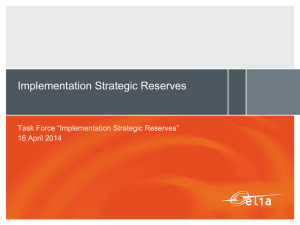Participation of demand in Belgian Balancing market
advertisement
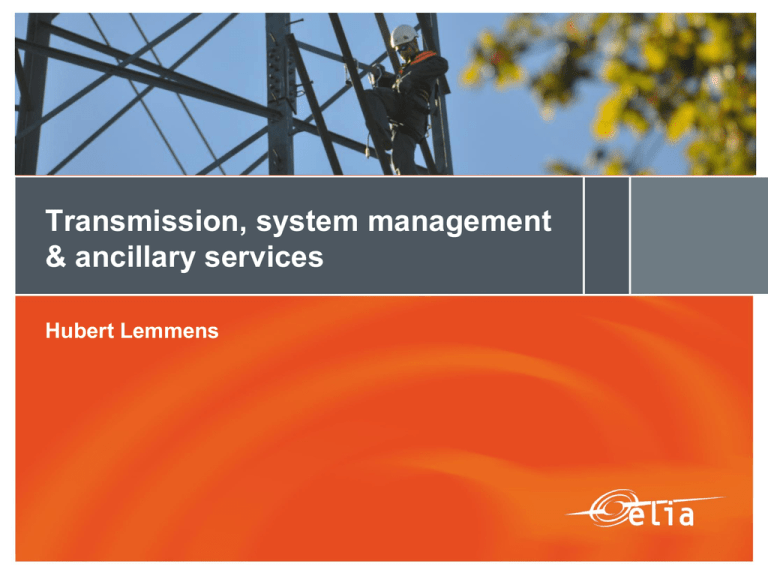
Transmission, system management & ancillary services Hubert Lemmens Agenda • • • • • Elia Group Electricity market Role of the different players Elia products and services Ancillary services • • • • Balancing Ancillary services AS markets Challenges & opportunities Agenda • • • • • Elia Group Electricity market Role of the different players Elia products and services Ancillary services • • • • Balancing Ancillary services AS markets Challenges & opportunities Elia Group - reliable and resilient networks Ownership Elia • 100% of 380-150kV network • 94% of high voltage network (70-30kV) 50Hertz • 100% of 380-220kV network 34% of the German 380kV network 19% owner of the German 220kV network Age of networks Elia • Less than 15 years for 50% of underground cables • Less than 25 years for 50% of lines & substations 50Hertz • Around 10 years for 90% of the network (refurbished after German reunification in 1989) 4 Elia + 50Hertz Transmission = Top 5 in Europe Elia Group 110-380 kV lines and cables 13,431 km 30 tot70 kV lines and cables 4,800 km Substations Served territory (km2) 872 ~ 143,000 Direct consumers ~ 130 Inhabitants > 30m Staff (FTE) ~ 1,900 Regulated Asset Base (RAB) € 5,843m 5 5 Elia’s Role Elia operates, maintains and develops a network consisting of lines, underground cables, transformers and substations linking producers and consumers of electricity Elia France Netherlands Luxembourg U.K.? Germany? France Netherlands Luxembourg U.K.? Germany? Exports Imports Large & Medium Industry Belgian producers Small Industry Electricity Generation Transmission 380 to 30 kV Distribution from 15 kV to 230 V Domestic Customers 6 The transmission grid: key in energy policy The European transmission system: • 34 interconnected countries • 532 million consumers • 880 GW installed generation • 3.200 TWh/year consumption • 380 TWh/year international exchanges The European transmission grid: • 305.000 km interconnections A remarkable technological accomplishment of the 20th century ! 7 Agenda • • • • • • • • • Elia Group Electricity market Role of the different players Elia products and services Ancillary services Balancing Ancillary services AS markets Challenges & opportunities Regulatory framework Europe • Liberalisation is an European initiative: – Creation of one European market – Free market … • Producers • Supply • System operator - Natural monopoly - Independent system operator - Strong regulation – With social and environment corrections 9 Power market design Power exchanges Power system operation ISO model 3rd pty Asset management 3rd pty TSO model Brasil, US, Korea, Australia,… Europe Critical interface Elia Group 10 EU Market Model Forward Day Ahead Intraday Balancing •Manage forward price and vol. Risk •Arbitrage •Maintenance planning •Investment planning •Manage STprice and vol. Risk •Close forward positions •Generation optimization (Make or buy) •Volume adjustment/fine tuning (T°, wind,…) •Outage management •System security 11 Power Markets: general framework Energy only markets Forward Multilateral market Capacity market Day ahead Intraday Balancing Reserves TSO is single buyer 12 Different electricity markets Retailers Retail Market Wholesale Market OTC and Exchange Traders Balancing Market 13 European power exchanges Products Bilateral, brokered or exchange-based Physical or financial delivery Forwards, futures, options and other derivatives Years, quarters, months, weeks, days, hours Price per delivery zone (~ country) 14 Agenda • • • • • • • • • Elia Group Electricity market Role of the different players Elia products and services Ancillary services Balancing Ancillary services AS markets Challenges & opportunities Market actors • • • • • 16 Producers – Produce electricity – Have a licence for production Suppliers – Sell the energy to the consumers – Have a supplier licence Traders – Buy and sell the energy, but don’t supply Grid Users – Are connected to the Grid (Transmission or Distribution) – Take energy off or inject energy in the Grid Grid operators (Transmission / Distribution) – Build and maintain Grid – Guarantee security and quality of supply – Control and manage balance, voltage, frequency and congestions – Promote the opening of the market 16 Roles and responsibilities Resource Adequacy Energy Balancing Ancillary service Responsibility: government/market Tools: • Measurement/ forecasts • Capacity remuneration schemes • Strategic Reserves Responsibility: energy market actors/ TSO (residual) Tools: • Direct control (dispatchable load) • Response to price signals (non-dispatchable load) Responsibility: TSO as buyer - generation&load as provider Tools: • Direct control (dispatchable load) options (pre-contracted) • DSOs involved, especially when Distribution grid congestion issues 17 Elia’s tasks Electrical system management High voltage infrastructure management Market facilitator Operation of the transmission network, including the management of the energy flows and the organisation of ancillary services. Management of the balance between injection and off-take of the network around the clock (7 days/7, 24 hours/ day) Maintenance of the transmission network and the implementation of the necessary investements to develop and improve the network. Grant access to the network on an objective and transparant basis. Development of instruments and systems that should enhance the good functioning of the market: hub, nominations, auction of transmission capacity at the borders, energy exchange, market coupling. 18 Elia is a market facilitator Nominations • • • • Transmission programme for every ARP and balance responsible party Validation by Elia Day ahead: normal procedure Intraday: in the event of an imbalance, restore balance through exchanges on the hub HUB • • IT platform for bilateral exchanges between ARPs to safeguard the balance Day ahead & intraday (intraday = in the event of unexpected imbalances) Balancing: offset imbalances Allocation of border capacities Energy exchanges: purchase and sell electricity anonymously • • Belpex: Belgian energy exchange with trilateral market coupling (Belgium – the Netherlands – France); APX: energy exchange between Belgium, the Netherlands and the UK Participation in Powernext, France’s energy exchange (via HGRT) CWE and CWE-Nordic ITVC market coupling: launched 9 November 2010 19 Agenda • • • • • • • • • Elia Group Electricity market Role of the different players Elia products and services Ancillary services Balancing Ancillary services AS markets Challenges & opportunities Product overview In its interactions with the market, we distinguish following categories of products: Services supplied to Grid Users • Connection to the Grid • Access to the Grid • • Use of the Grid Supply of ancillary services Management of balance Allocation of interconnection capacity Services contracted with third parties • Supply of energy for ancillary services • Coordination of Injection of Production (CIPU) 21 Product overview For each of them specific contracts are signed: 22 Principle BRP balanced day-ahead (ARP = BRP) 23 Goal : BRP must be in balance All Injections = All Off-takes (Sum IN = Sum OUT) Injections : Import from NL/FR Purchase on HUB Generation/ injection Off-takes : Export to NL/FR Sale on HUB Offtakes for direct clients or DGO Losses 24 Imbalance tariffs: objectives • – – – – • Incentive to avoid imbalances By good forecasting By participation on the intraday markets By use of own flexibility Incentive not to source on real time market => Ideal situation no regulating power need to be activated by the TSO Avoid excessive charges deterring market entry – ARP whose imbalances are zero on average and are not correlated to system imbalance will pay small imbalance charges on average. • Incentives to execute requested regulating power • • Transparency; real time publication XB harmonization Agenda • • • • • • • • • Elia Group Electricity market Role of the different players Elia products and services Ancillary services Balancing Ancillary services AS markets Challenges & opportunities General principles balance management Electricity consumption = generation on interconnected network otherwise: BLACK OUT! Balance between electricity consumption and generation: coordination between TSO’s Every BRP is responsible for maintaining ¼ h balance between total injections and total off-takes in his portfolio TSO ensures balance in its control area Balancing - Elia •Means of maintaining balance R1 R2 R3 Control Power stations: automatic VFR Elia: automatic SCADA Elia: manual Time unit ms sec - min 15 min •Primary reserve •Secondary control (LFC) •Incremental or decremental bids (non-contractual R3) •Contractual tertiary reserves (production and interruptible customers) •Inter-TSO emergency reserves – All the other small production units (‘MW Action’) – Defence Plan: U-5% – Defence Plan: interruption of load – Curtailing (in theory) Agenda • • • • • • • • • Elia Group Electricity market Role of the different players Elia products and services Ancillary services Balancing Ancillary services AS markets Challenges & opportunities System Services organised by Elia • – – – – – – – Essential for quality and reliability of power supply: #products R1, R2, R3: different kinds of reserve capacities to be activated by TSO Interruptible customers ICH Inter TSO support Voltage regulation Black start Congestion relieve Compensation for grid losses • – – – TSO responsibilities -> market design/architecture -> contracting/tools -> settlement/monitoring • Pass trough in tariffs – but good housekeeper principle (Regulatory scrutiny) 30 Primary Reserves Objective: to maintain a balance between GENERATION and consumption (DEMAND) within the SYNCHRONOUS AREA, using “primary controllers” • The activation of Primary reserves is based on local frequency measurment, installed by the supplier. – – Accurancy of 10mHz Minimum sample rate every 1-2seconds • The minimum activation time for R1 is: – – 50% of the contracted value after 15seconds 100% of the contracted value after 30seconds. 31 Primary Reserves Contracted capacity – transfer of obligations via sec. market • Suppliers can exchange their contractual obligation via the secondary market for R1 symm & R1 down. ARP A ? €/MW/h Bilateral transaction, price not known by Elia TRANSFER OF OBLIGATIONS ARP B R2 energy payment @ Pact(B) Reservation penalties Capacity payment @ Pres(A) €/MW/h Activation penalties Elia • • • Reservation penalties must be recovered from ARP B => Reservation penalties must become independent from reservation price! => Reservation penalties on QHs need to be independent from each other 32 Primary Reserves R1 remunerations • Remuneration for the reservation (capacity fee): – Paid on monthly basis • KB 2013: 45€/MW/h for the symmetrical part • Attention, in case of increased liquidity on the market, these prices are not representative. • No remuneration for the Activation: Energy up and energy down are the same in the time. 33 Secondary Reserves Principles Objective: SECONDARY CONTROL maintains a balance between GENERATION and consumption (DEMAND) within each CONTROL AREA • SECONDARY CONTROL makes use of a centralized AUTOMATIC GENERATION CONTROL, • Via a setpoint, Elia ask to modify the active power of GENERATION SETS in the time-frame of seconds to typically 15 minutes. • There are two types of regulation: • Upwards regulation: Elia can ask to produce more electricity than scheduled • Downwards regulation: Elia can ask to produce less electricity than scheduled • In case of multiple supplier, all suppliers are activated simultaneously and pro rata based on the total volume secondary that can be activated 34 Secondary Reserves Contracted capacity / selection • Contracted capacity: – Elia Contracts 140MW of Secondary reserves on a yearly basis from different suppliers. • Upwards/downwards regulation • Peak / off-peak – The contracted capacity must be available 100% of the time. • Possibility to exchange via a secondary market • Free Bids: – Every Supplier with an R2 contract can offer, day-ahead on quarterhour basis secondary reserves to Elia @ an activation price. 35 Secondary Reserves Contracted capacity / selection • Selection of Seconday reserves – Day ahead, Elia selects 150MW – The selection is done separately for upwards and downwards volumes – The selection is done every quarter hour – Economial ranking: • Lowest prices for upwards regulation (Elia buys energy and pays money to supplier) • Highest prices for downwards regulation (Elia sells energy and receives money from the supplier) 36 Secondary Reserves Secondary Market • Suppliers can exchange their contractual obligation via the secondary market. ARP A ? €/MW/h Bilateral transaction, price not known by Elia TRANSFER OF OBLIGATIONS ARP B R2 energy payment @ Pact(B) Reservation penalties Capacity payment @ Pres(A) €/MW/h Activation penalties Elia • • • Reservation penalties must be recovered from ARP B => Reservation penalties must become independent from reservation price! => Reservation penalties on QHs need to be independent from each other 37 Secondary Reserves Activation • • • Elia transmits a dynamic and continuous setpoint. The dynamic setpoint, represents the volume with which the supplier must increase/decrease its production. The supplier is required to keep the activated reserves equal to this signal. – Maximum deviation of 15% – The slope of the setpoint is defined by the total selected volume in a direction devided by 7,5 minutes. – The dynamic setpoint is updated every 5 seconds. 38 Secondary Reserves Remuneration • Remuneration for the reservation (capacity fee): – Paid on monthly basis • KB 2013: 22,5€/MW/h in one direction • Attention, in case of increased liquidity on the market, these prices are not representative. • Remuneration for the Activation: – Remuneration for the energy (separate for upwards and downwards for each QH) – Day-ahead the supplier communicates the volume of reserves + the price of activated energy. These prices are subject to price caps • Price for upwards energy < the fuelcost of a standard CCGT +40€ • Price for downwards energy > 0€ – These prices are used for the selection of R2 39 Tertiary Reserves Principles Objective: Reserve power with which ELIA can restore the balance between the supply of and demand for active power within the Control Area. • Specifically: “A third line of reserve to resolve major imbalances” – – – Cope with a major or systematic imbalance in ELIA control zone Offset a significant frequency variation Resolve major congestion problems • Only upwards • Activated manually • To be activated within 15 minutes • 400MW from Production units 40 Tertiary Reserves Contracted capacity • Contracted capacity: – Elia Contracts 400MW of Tertiary reserves on a yearly basis from different suppliers. • Upwards regulation • Peak / off-peak – • The contracted capacity must be available 100% of the time. Free bids: Free bids are managed via the CIPU contract (coordination for injection of production units) – – Principle: all production units that are minimum stand-by (not in revision) offer their capacity to Elia on a quarter-hour basis. Upwards and downwards volumes. 41 Tertiary Reserves Activation • Activations of tertiary reserves are based on a technical-economic merrit order: – – • First activation of free bids, merrit-order When all free bids are used, activation of R3, merrit order Manual activation by the system operation via a communication platform “Probid” 42 Tertiary Reserves Remuneration • Remuneration for the reservation (capacity fee): – Paid on monthly basis • Cost-based + margin • Remuneration for the Activation: ‒ Energy delivered • ~ incremental in procedure nomination of daily bids (D-1 for day D) in CIPU Art.13.2.5 ‒ Startup-costs • ~ as specified in CIPU (depending on fueltype & cost) • If and only if • Pnom ≤ Pmin before and after activation quarter (calculated as average on 4 qtrs) • Startup-time <= 15 minutes (=M) • No FO during bid 43 Interruptible demand Principles • Objective: Reserve power, with which ELIA can restore the balance between the supply of and demand for active power within the Control Area. • a grid user interrupts a part of its offtake in a timeframe of 3minutes • An interruption = lowering the actual offtake of that moment below a contractual fixed value, SL(“Shedding Limit”) P(offtake) SL Activation period • • time 3 different variations of the product – SLA2: 12 activations of maximum 2 hours – SLA4: 4 activations of maximum 4 hours – SLA8: 4 activations of maximum 8 hours Different Accespoints per contract are possible. (open for aggregators) 44 Interruptible demand Contracted capacity • Contracted capacity: – Elia Contracts yearly 261MW from different suppliers • Upwards regulation (interuption of offtake) • Peak/offpeak/weekend – In average 100% availability during the year: • the average reserve made available over the whole year must be at least 100% • 87 hours(1% of the time) unavailability is allowed. 45 Interruptible demand Activation • Elia activates, by remote control, a device located in the grid user’s process • When this signal is received, the grid user’s offtake must drop below the shedding limit within 3 minutes after Elia’s request; • – – – The offtake must remain below the SL until Elia send a deactivation signal of the maximum contractual activation time is reached: SLA2: maximum 2 hours SLA4: 4 maximum 4 hours SLA8: 4 maximum 8 hours • Between 2 activations is at least 24 hours • Elia cannot activate in case the Supplier has communicated unavailability to Elia (max 87h/year) 46 Interruptible demand Remuneration • Remuneration for the reservation (capacity fee): – Remuneration for the actual reserve power made available through the year • Reserve power made available= average offtake of the year for the considered period(Peak/Offpeak/Weekend) – Shedding Limit for the considered period P(offtake) Average offtake SL time – Monthly fixed fee for the contracted reserve Power – Settlement at the end of the year: average reserve power made available 1. Surplus: extra remuneration of 20% of the contracted price 2. Less than 3% missing reserve power: 100% recovering of the remuneration 3. More that 3% missing reserve power: 120% recovering of the remuneration reserve power not made available (recuperation of the remuneration + 20% penalty) Average Reserve power made available / Contracted reserve power (2) (3) 0 97 (1) 100 47 Interruptible demand Remuneration • Remuneration for the Activation: – Remuneration for the energy • The activated energy is considered as the difference between the actual offtake and the nomination, capped a the difference between the SL and the nomination. • Price= max [ 75€/MWh ; 108%*Belpex ] Offtake Remunerated energy Activation Deactivation 48 Activation of ancillary services: Balancing • All selected secondary reserves (150 MW) are activated proportionally to obtain maximum flexibility with available R2 portfolio • If the system imbalance exceeds 150 MW manual reserves are activated in a merit order (Free bids) • Once all free bids are exhausted, Elia start with activations of R3 production • R3 load shedding contracts can only be activated 5 times a year • InterTSO emergency reserves are activated once all available reserves in the control area are exhausted • Generally: Other System services Black start – MVAR • Black Start If black out occurs…. • Restore critical load (10%) after 7 hours • Restore complete load after 14 hours • For 5 zones in Belgium (NW, NE, SW, SE et Centre) one black start unit of at least 200MW is foreseen • MVAR – Voltage • • MVAR needed for quality of voltage – local Different sources: • Investments: Self (capacitive) of condensator (inductive) (GD) • Contract producers (ENMAN) 50 Grid losses • Federal grid losses • Federal Grid code (380/220/150 kV) • Grid losses need to be compensated in natura: ARP’s need to inject a % more than the offtakes. • +/- 950 GWh a year • Currently +/- 1% • Regional grid losses • Regional Grid code (70/36/30 kV) • Grid losses need to be purchased by the transport system operator • +/- 500 GWh a year 51 Agenda • • • • • • • • • Elia Group Electricity market Role of the different players Elia products and services Ancillary services Balancing AS markets Ancillary services Challenges & opportunities Belgian Ancillaries market • 1 big player (≈65% production capacity) • Few providers of AS • Nuclear represent a dominant share but participation to ancillaries is limited • No modern coal plants with high running hours • Continuous decrease of running hours of CCGT’s 53 Lack of liquidity • Pressure on reserves (and downward balancing energy) in Belgium • Underlying facts: – Penetration RES, increasing need of reserves but not delivering System Services, and decreasing availability of flexible plants (CCGTs less & less in operation, out of merit order) – Market perceives price for System Services as too low and products/ sourcing process as inflexible (1Y cycle) – Regulatory framework acts as a disincentive. – > 50% of R3 (Tert. Reserve) could close in next 5 years – More frequent and severe incompressibility situations Possible solutions: working on different axis Improve System Imbalances at the source (ARP): • • • • Single marginal imbalance tariff since 01/01/2012 Enhance balancing publications: e.g. wind and solar forecastings Continued market integration (NWE intraday, etc.) Etc. Diversify assets providing balancing services: • • • • • In 2013 - R1/R2 contracts revised to allow a variety of assets Load participating in supply of primary control (2013) Participation of aggregators in the supply of interruptible load (2013) RES, Storage Realise XB-synergies: • • • • • Participation of BE to iGCC (imbalance netting with 6 countries incl. DE) Intensive participation in the Network code drafting team Study into potential BE-NL XB synergies (with Tennet NL) Further investigations for iGCC evolutions Etc. 55 Agenda • • • • • • • • • Elia Group Electricity market Role of the different players Elia products and services Ancillary services Balancing Ancillary services AS markets Challenges & opportunities Physical reality Forecast – actual: 5 GW Max-min generation : 23 GW Forecast – actual : 2 GW Delta peak in 1 week: 9 GW In Belgium: Wind ~1400 MW PV ~2200 MW 57 Low wind conditions (Germany) 58 Flexibility will be needed and Valued! 1 week wind generation in Germany Examples: important differences between minimal and maximal generation from intermittent sources 1 week solar generation in Belgium TSOs need flexibility to keep the balance between supply and demand, by mobilizing all potential sources of flexibility within the grid, generation and the demand side! In the real-time balancing market In the Intraday market Outside the balancing market, but in timeframes between DAY AHEAD and REALTIME: Potential for strategic reserves 59 Courtesy to Boston Consulting Group 60 Baseload Prices in Be and neighbours • Continuing general downwards trend of prices 61 Courtesy to Boston Consulting Group 62 .. System Adequacy & EU Market model … while shale gas in the US pushes gas out of the market in the EU and support mechanisms drives RES investments… 2013: EON to close 11 GW, Gdf to close…, etc x 1,4 EU States moving quickly towards “capacity markets”, “strategic reserves”, … Daniel Dobbeni | 28-30.10.2013 | Page 63 .. System Adequacy & EU Market model Concern: How to ensure reliability when decisions are taken in an uncoordinated way? How to avoid TSOs being blamed for this lack of coordination? Source: ENTSO-E Daniel Dobbeni | 28-30.10.2013 | Page 64 Storage • Storage often considered as the silver bullet • Able to provide short term fexibility • Weak business case for arbitrage on power market • Requires high investments 65 Technical performances from a grid perspective • • • • • Storage brings flexibility: Easy start and stop Fast ramping rates Source of Ancillary services Optimizing grid use – investment deferral •Constraints: • Limited energy content • Mechanical based storage needs minimum generation or load •Developments: • Multi purpose optimizing tools • Cost decrease 66 Belgian electricity system Cases of interest Energy Island (Offshore – Belgian Coast) • • • 2,5 km diameter 10 m above sea level 300 MW http://gtms1303.wordpress.com/2013/01/28/an-artificial-energy-atoll-at-the-belgian-coast/ • Potential services: • Reserves (e.g. R2)? • Arbitrage? • Bulk storage for integration of off-shore wind? 67 Storage in Europe Elia current position Storage offers resources for: • Balancing (Balance resp. party) • Ancillary services (TSO use) In competition with other resources: • Flexible generation • DSM Prefered path: • Technology neutral markets for Ancillary services • Multi purpose storage has best perspectives Last resort: if market doesn’t deliver, regulated investment not excluded. 68 Thank you ! 69
